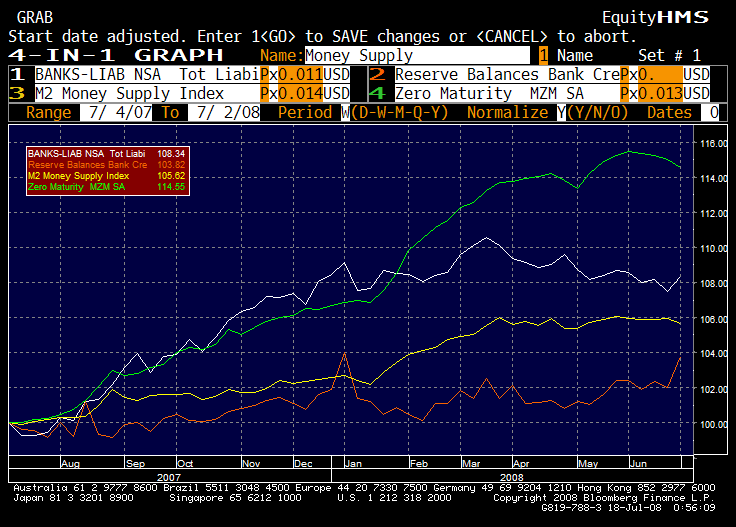I haven’t written about the Fed much recently, largely because little has changed.? The Fed is frozen in its position.? Can’t raise rates because the banking system is on edge (and now the Fed informally cares for the systemic risk created by the investment banks).? Can’t raise rates because labor unemployment is rising.? Can’t lower rates because inflation is moving up.? Can’t lower rates because the dollar will dive.? What a pickle!

This is my monetary aggregates graph over the last year.? Growth of the monetary base is anemic, but that is intentional.? Rather than let the monetary base grow through the purchase of Treasuries, the Fed is using its balance sheet to add liquidity to certain money markets.? When was the last time the Fed did a purchase of Treasuries?? 5/3/07.? I think this is the longest period in the Fed’s history without a purchase of Treasuries, and I have written the Fed to ask, but alas, no answer.? For comparison purposes, there is a tool at the NY Fed website that allow you to look at permanent open market operations after August 25, 2005.? How many purchases of Treasuries during the tightening/flat period from 8/25/05 to 5/3/07?? Fifty-nine.? Fifty-nine during a predominantly tightening period, and not one during a loosening period?
I point this out because the Fed is behaving very differently under Bernanke than any Fed Chair since the Great Depression.? Part of it is the situation in the capital markets.? Leverage got too high among a number of big capital markets players, and the SEC didn’t do diddly.
But under this new arrangement, liquidity goes out to the capital markets through the Fed’s new programs, but not out (at least not directly) to the commercial banking system and the general economy.? The balance sheets of some financial entities get relief, but not much stimulus makes it into the general economy.? What liquidity that is created gets extinguished by the Fed, because they sell/lend Treasuries to fund their lending programs.
Taking a quick spin around the globe, inflation is viewed as a major threat, enough so that the ECB raised its policy rate to 4.25%.?? There may not be a lot more rises, but the likely direction of ECB policy is up not down.
China is having inflows of hot money, and much as the central bank keeps raising deposit requirements, it does little good.? Inflation keeps rising.
It’s an inflationary world, and one of the reasons that the US is not feeling it as bad is that we are the world’s reserve currency.? So long as China and OPEC keep buying US debts, the game can go on, but woe betide us if the music stops.
At present, Fed funds futures indicate a Fed that is frozen.? No more moves in 2008.? Using my “pain model” for the Fed (the Fed acts to minimize its political pain), I would concur.? When you don’t know what will work, doing nothing seems like a great plan.
A great plan for now, that is.? My guess is that the Fed can’t be out of step with the rest of the world for too long, and in 2009, they will begin tightening, even if the economy and the banks are weak.

No coupon passes for over a year has stumped me as well. I guess when you make non-recourse loans of $30 billion, you don’t have to.
Kind of surprising that the dollar index hasn’t broken below 70, given the state of the American economy and the rate spread among world currencies. Like you said–different ball game when the world wakes up.
Indeed, especially with a Presidential election coming this November, the Fed will stay put.